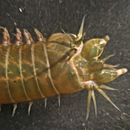Look Alikes
(
Inglês
)
fornecido por Invertebrates of the Salish Sea
How to Distinguish from Similar Species: The large, strap-shaped upper ligule in the posterior notopodia is very helpful in identifying this species. In Nereis grubei and N. neoneanthes the upper ligule of the posterior notopodia is not strap-shaped. Nereis wailesi has no paragnaths on the distal proboscis. Nereis brandti has no homogomphfalcigerous setae on the posterior notopodia and the dorsal ligule of the parapodia is large and leaflike.
- licença
- cc-by-nc-sa
- direitos autorais
- Rosario Beach Marine Laboratory
Habitat
(
Inglês
)
fornecido por Invertebrates of the Salish Sea
Intertidal with mussels and barnacles, on pilings, in sandy mud and cobbles, and in algal holdfasts.
- licença
- cc-by-nc-sa
- direitos autorais
- Rosario Beach Marine Laboratory
Distribution
(
Inglês
)
fornecido por Invertebrates of the Salish Sea
Geographical Range: Alaska to San Diego; Pacific coast of Russia
- licença
- cc-by-nc-sa
- direitos autorais
- Rosario Beach Marine Laboratory
Habitat
(
Inglês
)
fornecido por Invertebrates of the Salish Sea
Depth Range: Mid to low intertidal
- licença
- cc-by-nc-sa
- direitos autorais
- Rosario Beach Marine Laboratory
Comprehensive Description
(
Inglês
)
fornecido por Invertebrates of the Salish Sea
As a member of Family Nereididae, few if any segments are longer than wide, the notosetae from the two sides do not almost meet along the dorsal midline, the prostomium does not extend as a dorsal caruncle back over the segments posterior to it, there is no circle of tentacles around the mouth, the prostomium has two antennae, and a pair of palps which are differentiated into two units, the distal unit of which is substantial even though it is smaller than the proximal unit. Some of the setae are compound. The pharynx is delineated into two parts, with a pair of stout jaws on the distal part and conical teeth on both parts. The peristomium has four pairs of tentacular cirri which arise on the anterolateral corners. Usually two pairs of eyes are present. The parapodia on the first two setigers are uniramous, and biramous on all subsequent setigers. Both the notopodia and the neuropodia have acicular lobes which are often small, plus one to three conspicuous lobes above and below the acicular lobes called ligules. The shape and arrangement of the ligules varies among species. In Nereis vexillosa the ventral cirrus of all parapodia is simple, the tentacular cirri of the peristomium are not constricted into several units, the segment behind the peristomium is not expanded into a large collar around the peristomium, all of the paragnaths on the eversible proboscis are conical, some paragnaths are present on the distal part of the proboscis, the posterior notopodia have homogomph falcigerous setae, and the upper ligule of the notopodia in the posterior region is much larger than the lower ligule and is strap-shaped, with a terminal cirrus. Color is greenish or greenish brown, often with blue tones; may appear iridescent in direct sun. Has 4 black eyes. The tentacular cirri are short. The animal is often large--up to 30 cm long and 1.2 cm wide.
- licença
- cc-by-nc-sa
- direitos autorais
- Rosario Beach Marine Laboratory
Comprehensive Description
(
Inglês
)
fornecido por Invertebrates of the Salish Sea
Biology/Natural History: The large jaws on the distal portion of the eversible pharynx are used for seizing prey or tearing algae. The smaller denticles on the proximal portion are used for burrowing. Family Nereididae are called sea nymphs and are common polychaete worms in this area. Intertidal species are sometimes called ragworms. Nereids reproduce by releasing parts of their body as epitokes, which swim to the surface in mating swarms. Nereid epitokes are swollen with eggs or sperm, large parapodia, paddle-like chaetae, and large eyes. Day length is important in swarming of epitokes, and near-shore lights can affect the timing of swarms. In our area, spawning may occur shortly before midnight. The mating swarms release pheromones into the water which induces mating activity. The male epitokes swarm first and the females will not release their eggs unless in the presence of the males. The eggs are released into the water in the swarms, through ruptures in the body walls. In N. vexillosa the female releases an agglutinating material along with her eggs. Both male and female epitokes die after spawning. The mass, with eggs inside, sinks to the bottom and grows to about the size of a bluish-green chicken egg. Larvae remain as plankton for hours to months. In the Pacific Northwest the mating swarms usually occur in late winter or spring. This worm is often used for fishing bait. It squirms violently and everts its proboscis and jaws when captured, and may bite.
- licença
- cc-by-nc-sa
- direitos autorais
- Rosario Beach Marine Laboratory

